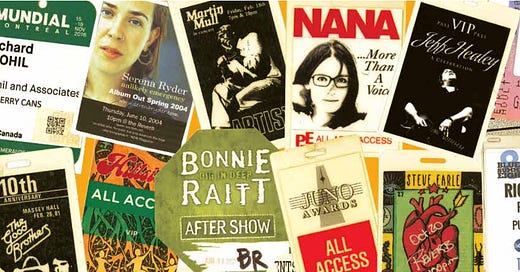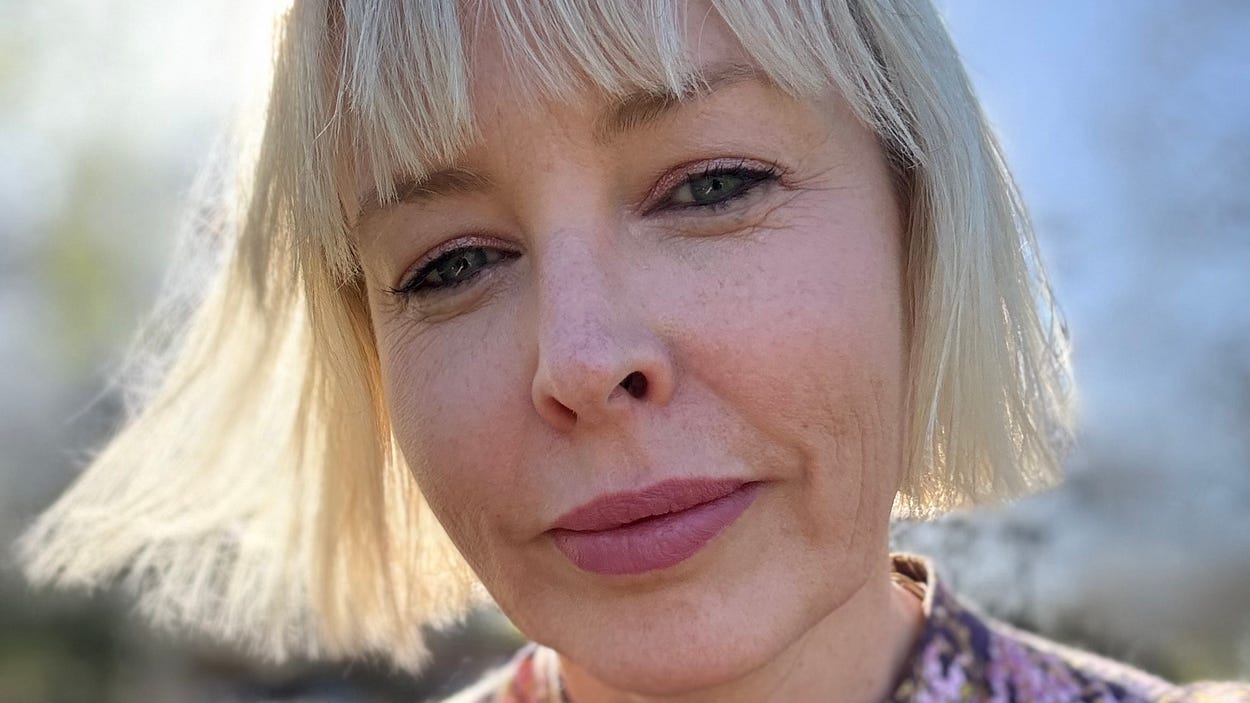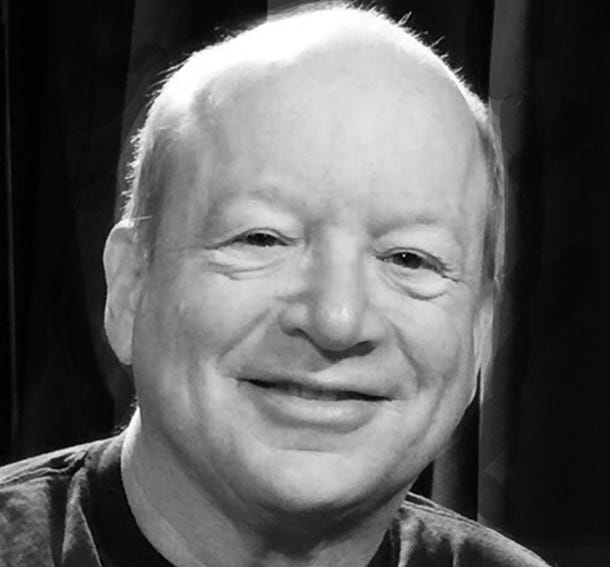Stories from the Edge of Music #57: WHY TO WRITE A SUBSTACK
Plus, more Bob Lefsetz and festival news
A quick “backgrounder” to explain how and why this Substack is what it is, and to express the hope you’ll continue to read it. And thanks to Leah McLaren’s recent Substack, which kicked my ass to offer you this catch-up…

WHY YOU SHOULD CREATE A MEMOIR
Leah McLaren used to be a columnist in my favourite (if flawed) newspaper, The Globe and Mail.
Now she writes a Substack column called Juvenescence, lives in London and raises two boys as a single mom.
She recently wrote a piece about the differences between writing novels and memoir. It resonated with me because I’ve been writing this memoir — in new instalments every week or 10 days — for more than a year and a half.
She put it this way: “ A novel is deep and wet and full of twisting currents; many people get lost and give up … you’d be wise to learn how to swim.
“Memoir is different. For many writers, the setting out of life on the page is a fulfilling end in itself. Articulating experience … is always a valuable undertaking.
“Humans turn our lives into stories,” she adds.
Stories from the Edge of Music began as a book — okay, a memoir — with a grabber of a title: The Night Miles Davis Tried to Buy My Car — and 100 Other Stories from the Edge of Music.
As I wrote, my art director, Michael Wrycraft, designed the pages, with pictures and sidebars and interesting graphics. Then Michael died. And soon afterwards, my fiend Al Mair — who was helping finance the project — also died. And if you half-believe disasters come in threes, it seemed a good time to quit.
And then COVID happened.
In May 2023, with the plague receding, I heard about Substack (which still isn’t as well known as it deserves to be) and thought this might be the place to tell the stories I had planned for the book.
To quote Leah once more: “Everyone has a memoir in them. The sheer abundance of memory is what makes writing a memoir so gloriously doable … we are all multitudes and within those multitudes are an infinite number of stories, just waiting to be teased out and typed up.”
So we are up to 57 installments of my memories and stories. I’m still not sure that “articulating experience is always a valuable undertaking” — I just wanted to tell these stories to entertain my friends (including all of you), and perhaps add to a remembered history of the music I heard and the artists that I met.
Let Leah write the rest of this: “Outside the immediate present moment — this, now — memory is all we have … without memories, our lives would not add up. Without memories, there would be no stories.
“After food, water, oxygen and love, stories are what keep us alive.”
As one of the oldest writers on Substack — I’ll be 91 in June — I’m beginning to understand that stories are what’s keeping me alive!
+++++++++++++++++++++++++++++++++++
BOB LEFSETZ (PART 2)
What artists are
Last time out I included the first part of a post that the LA-based music biz guru wrote some time ago for his widely read newsletter. If you missed Part 1, you can read it here.
What Bob attempted to do is define who artists are, and what, ideally, they should do to succeed. His “rules” — reprinted here with his permission — may surprise you.
An artist…
• Is savvy enough to know they are not always the best judge of their work.
• Has to create, or they risk depression.
• Is internalized. At best, they can relate to another artist.
• Is a member of a separate tribe. The public can appreciate the work, but can never really understand the germ of creation.
• Speaks through their work.
• Their work needs no explanation, it stands on its own.
• Is willing to change. The greats reinvent, the middling class rests on their laurels.
• Is challenging their audience on a regular basis, and if they’re not getting a mix of feedback, both positive and negative, they’re not doing it right.
• Knows that execution is secondary to inspiration. Just because you completed it, that does not mean it’s art.
• Is gobbling up information in their field. Not so much to suss out the competition, but to marinate in the artistic field in which they endeavour. Writers read. Painters go to galleries. Musicians listen to music.
• Knows that art is viewed in a context. And that by challenging the context, people oftentimes can’t understand what you’re doing and castigate it.
• Knows that if you listen to all the feedback you’ll be unable to create at all.
• Their best work is done when they’re in a zone. It can’t be artificially created: it’s something you feel, not something you can explain.
If Bob’s words make sense to you, and I know they will, please feel free to share this with any artists among your friends.
++++++++++++++++++++++++++++++++++++
SOME FESTIVAL NEWS
Good news: The Calgary Blues Festival has found a new site, after Millennium Park was turned into a giant bar for Stampede this summer. More news as it comes in.
++++++++++++++++
Bad news: A few issues back I listed a couple of festivals that will no longer happen — but I forget to tell you about the Vancouver Island Music Festival. Rising costs and meagre outside funding (about four per cent of the budget) caused the board of directors to see the festival as a risky gamble, and asked programmer Doug Cox to book new-country artists and some retro rock bands.
He refused. “For me it was always about the music first. It was also about paying attention to diversity in all of its forms. New country and old rock wouldn’t fit.
“I am really proud of what I did. I didn’t want to water that down just to keep my job going as artistic director.”
And so he quit, and the board pulled the plug. After 28 years, central Vancouver Island won’t have a festival.
+++++++++++++++++
Good news Down Under: In distant Australia, one of the biggest music festivals in the world — Bluesfest Byron Bay — is hanging in, and is happening this weekend. A few months ago it was going to be cancelled.
This is a festival that once had Paul Simon and Bob Dylan on the same bill, and which actually has some blues artists in the lineup. Peter Noble, the cheerful boss of the long-running event, apparently got some better support from Aussie arts bodies — so the event was back on. Headliners this time are Crowded House, Chaka Kahn, Allison Russell and George Thorogood.
Apart from Crowded House, the festival is also featuring some other heavy duty Australian artists — relatively unknown this side of the Pacific — including John Butler, Missy Higgins and the Cat Empire.
+++++++++++++++++
Good news: The Canmore Folk Festival is the smallest one I go to, but it’s a favourite. Perhaps a quarter of the size of the “big” festivals like Winnipeg and Edmonton, it always offers an interesting lineup that punches above its weight.
It’s also in good shape. Artistic director Jenna Klein-Waller put it this way: “(The festival) does not face immediate, urgent challenges. However, I’m fully aware of the long-term challenges we (and all festivals) must navigate.
“There is growing pressure to book ‘bigger headliners.’ For Canmore, this is neither feasible nor aligned with our artistic vision, so there is always a challenge of navigating audience expectations.”
Echoing many other conversations I’ve had with other “folk” festivals, she added: “At the same time, I’m focusing on cultivating a new audience as our current one ages. I am carefully and strategically shifting programming to attract new attendees while preserving what makes the festival special.
“Overall, I am feeling good about the direction and sustainability of the festival — but I certainly don’t take that for granted.”
+++++++++++++++++++++++++++++++++++++
QUOTE OF THE WEEK
“If Teddy Roosevelt advocated the negotiation style of ‘speak softly and carry a big stick,’ we now have Trump’s ‘shake a (golf) iron club and wield an inflated penis.’”
— Tina Brown’s Substack:
++++++++++++++++++++++++++++++++++++
NEXT TIME…
Hanging around with Joe Boyd, the best damn storyteller of ’em all; plus a Jeff Healey story and a few words of wisdom from, of all places, the Wall Street Journal. And there will always be more.
Due diligence: In a few weeks, the donation for this Substack will increase (inflation, tariffs, etc!) The donation for present paid subscribers will stay the same ($6 a month, which is much less in US$ or UK pounds). So a paid subscription now will save you money. And will supplement my old-age pension and pay for the coffee I drink to come up with these missives.







ps. I had a free and a paid sub to your thing. I cancelled the free one today as it was redundant. happy to continue w the paid. go for a soda.
I agree with all this and I appreciate you having been a bit of a trailblazer in making a move over here… I also noticed that as an app and as a place to go to communicate, Substack is getting better and better while other social media homes are sort of getting worse and worse
It’s always good to know that you’re out there writing, Richard
keep on keeping on